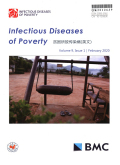- 钛学术文献服务平台 \
- 学术期刊 \
- 医药卫生期刊 \
- 内科学期刊 \
- 贫困所致传染病(英文)期刊 \
null
Health economic evaluation of moist wound care in chronic cutaneous leishmaniasis ulcers in Afghanistan
基本信息来源于合作网站,原文需代理用户跳转至来源网站获取
摘要:
Background:The present health economic evaluation in Afghanistan aims to support public health decision makers and health care managers to allocate resources efficiently to appropriate treatments for cutaneous leishmaniasis (CL) elicited by Leishmania tropica or Leishmania major.Methods:A decision tree was used to analyse the cost and the effectiveness of two wound care regimens versus intra-lesional antimony in CL patients in Afghanistan.Costs were collected from a societal perspective.Effectiveness was measured in wound free days.The incremental cost-effectiveness ratio (ICER) and incremental net monetary benefit (NMB) were calculated.The model was parameterized with baseline parameters,sensitivity ranges,and parameter distributions.Finally,the model was simulated and results were evaluated with deterministic and probability sensitivity analyses.Final outcomes were the efficiency of the regimens and a budget impact analysis in the context of Afghanistan.Results:Average costs per patients were US(S)11 (SE=0.016) (Group Ⅰ:Intra-dermal Sodium Stibogluconate [IL SSG]),US(S)16 (SE =7.58) (Group Ⅱ:Electro-thermo-debridement [ETD] + Moist wound treatment [MWT]) and US(S) 25 (SE =0.48)(Group Ⅲ:MWT) in patients with a single chronic CL ulcer.From a societal perspective the budget impact analysis shows that the regimens' drug costs are lower than indirect disease cost.Average effectiveness in wound free days are 177 (SE=0.36) in Group Ⅱ,147 (SE=0.33) in Group Ⅲ,and 129 (SE=0.27) in Group Ⅰ.The ICER of Group Ⅱ versus Group Ⅰ was US(S) 0.09 and Group Ⅲ versus Group Ⅰ US(S) 0.77,which is very costeffective with a willingness-to-pay threshold of US(S) 2 per wound free day.Within a Monte-Carlo probabilistic sensitivity analysis Group Ⅱ was cost-effective in 80% of the cases starting at a willingness-to-pay of 80 cent per wound free day.Conclusions:Group Ⅱ provided the most cost-effective treatment.The non-treatment alternative is not an option in the management of chronic CL ulcers.MWT of Group Ⅲ should at least be practiced.The costeffectiveness of Group Ⅲ depends on the number of dressings necessary until complete wound closure.

推荐文章
期刊_丙丁烷TDLAS测量系统的吸收峰自动检测
带间级联激光器
调谐半导体激光吸收光谱
雾剂检漏 中红外吸收峰 洛伦兹光谱线型
不同盐度、温度及光照对漂浮浒苔生理生态的影响
浒苔
盐度
温度
光照
生理生态
期刊_联合空间信息的改进低秩稀疏矩阵分解的高光谱异常目标检测
高光谱图像
异常目标检测 低秩稀疏矩阵分解 稀疏矩阵 残差矩阵
内容分析
关键词云
关键词热度
相关文献总数
(/次)
(/年)
文献信息
| 篇名 | Health economic evaluation of moist wound care in chronic cutaneous leishmaniasis ulcers in Afghanistan | ||
| 来源期刊 | 贫困所致传染病(英文) | 学科 | |
| 关键词 | |||
| 年,卷(期) | 2018,(1) | 所属期刊栏目 | |
| 研究方向 | 页码范围 | 63-78 | |
| 页数 | 16页 | 分类号 | |
| 字数 | 语种 | 英文 | |
| DOI | 10.1186/s40249-018-0389-4 | ||
五维指标
引文网络
引文网络
二级参考文献 (0)
共引文献 (0)
参考文献 (18)
节点文献
引证文献 (0)
同被引文献 (0)
二级引证文献 (0)
1900(1)
- 参考文献(1)
- 二级参考文献(0)
1999(1)
- 参考文献(1)
- 二级参考文献(0)
2000(1)
- 参考文献(1)
- 二级参考文献(0)
2001(1)
- 参考文献(1)
- 二级参考文献(0)
2002(1)
- 参考文献(1)
- 二级参考文献(0)
2005(3)
- 参考文献(3)
- 二级参考文献(0)
2006(1)
- 参考文献(1)
- 二级参考文献(0)
2007(2)
- 参考文献(2)
- 二级参考文献(0)
2008(2)
- 参考文献(2)
- 二级参考文献(0)
2012(1)
- 参考文献(1)
- 二级参考文献(0)
2013(2)
- 参考文献(2)
- 二级参考文献(0)
2014(2)
- 参考文献(2)
- 二级参考文献(0)
2018(0)
- 参考文献(0)
- 二级参考文献(0)
- 引证文献(0)
- 二级引证文献(0)
引文网络交叉学科
相关学者/机构
期刊影响力
贫困所致传染病(英文)
主办单位:
中华医学会
出版周期:
双月刊
ISSN:
2095-5162
CN:
10-1399/R
开本:
出版地:
上海市黄浦区瑞金二路207号
邮发代号:
创刊时间:
2016
语种:
eng
出版文献量(篇)
434
总下载数(次)
0
期刊文献
相关文献
推荐文献

 免费查重
免费查重










